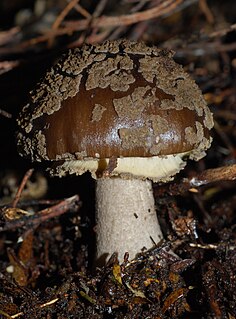
Miletus symethus, the great brownie, is a small butterfly found in India that belongs to the lycaenids or blues family. The species was first described by Pieter Cramer in 1777.

Pandemis cerasana, the barred fruit-tree tortrix, is a moth of the family Tortricidae.

Buzara onelia is a moth of the family Erebidae. It is found from the Indian subregion to Sri Lanka, Myanmar, Sundaland, the Philippines and Japan.

Buzara umbrosa is a moth of the family Erebidae. It is found in China, India and Sri Lanka.

Amanita nothofagi is a species of fungus in the family Amanitaceae. Endemic to New Zealand, the species was first described by mycologist Greta Stevenson in 1962. The fruit bodies have dark brown caps that are up to 13 cm (5.1 in) in diameter and covered with patches of soft greyish-brown scales or warts. The gills underneath the cap are crowded together, free from attachment to the stem, and white, becoming tinged with yellow in age. The stem of the mushroom is 4–14 cm (1.6–5.5 in) long by 0.5–2.5 cm (0.2–1.0 in) thick, and has a ring. The spore print is white, and individual spores are spherical to ellipsoid, measuring 7.5–9 by 7.5–9 micrometres. The mushroom may be confused with another New Zealand species, A. australis, but can be distinguished by certain characteristics. Amanita nothofagi is a mycorrhizal species, and grows in association with native New Zealand trees such as Southern Beech.

Megalopyge is a genus of moths in the family Megalopygidae.
Megalopyge amita is a moth of the family Megalopygidae. It was described by William Schaus in 1900. It is found in Brazil.
Megalopyge lapena is a moth of the family Megalopygidae. It was described by Schaus in 1896. It is found in Mexico and southern Arizona.
Megalopyge radiata is a moth of the Megalopygidae family. It was described by Schaus in 1892. It is found in Mexico and Brazil.
Megalopyge hyalina is a moth of the Megalopygidae family. It was described by William Schaus in 1905. It is found in Brazil.
Megalopyge megalopygae is a moth of the Megalopygidae family. It was described by Schaus in 1905. It is found in French Guiana.
Megalopyge obscura is a moth of the Megalopygidae family. It was described by Schaus in 1905. It is found in French Guiana.
Megalopyge affinis is a moth of the family Megalopygidae. It was described by Herbert Druce in 1887. It is found in Mexico.
Megalopyge chrysocoma is a moth of the Megalopygidae family. It was described by Gottlieb August Wilhelm Herrich-Schäffer in 1856. It is found in Venezuela.
Megalopyge ravida is a moth of the family Megalopygidae. It was described by Herbert Druce in 1887. It is found in Mexico.
Megalopyge salebrosa is a moth of the Megalopygidae family. It was described by James Brackenridge Clemens in 1860. It is found in Mexico and Guatemala.
Megalopyge tharops is a moth of the family Megalopygidae. It was described by Caspar Stoll in 1782. It is found in French Guiana and Brazil.
Megalopyge undulata is a moth of the family Megalopygidae. It was described by Gottlieb August Wilhelm Herrich-Schäffer in 1858. It is found in Brazil, Paraguay and Argentina.

Podalia orsilochus is a moth of the Megalopygidae family. It was described by Pieter Cramer in 1775. It is found in Mexico, Costa Rica, Brazil, Guyana and Venezuela.
Podalia walkeri is a moth of the Megalopygidae family. It was described by Carlos Berg in 1882 and is found in Brazil.





